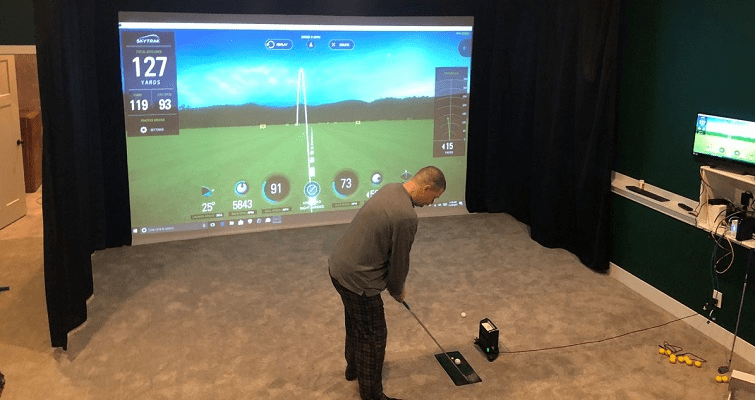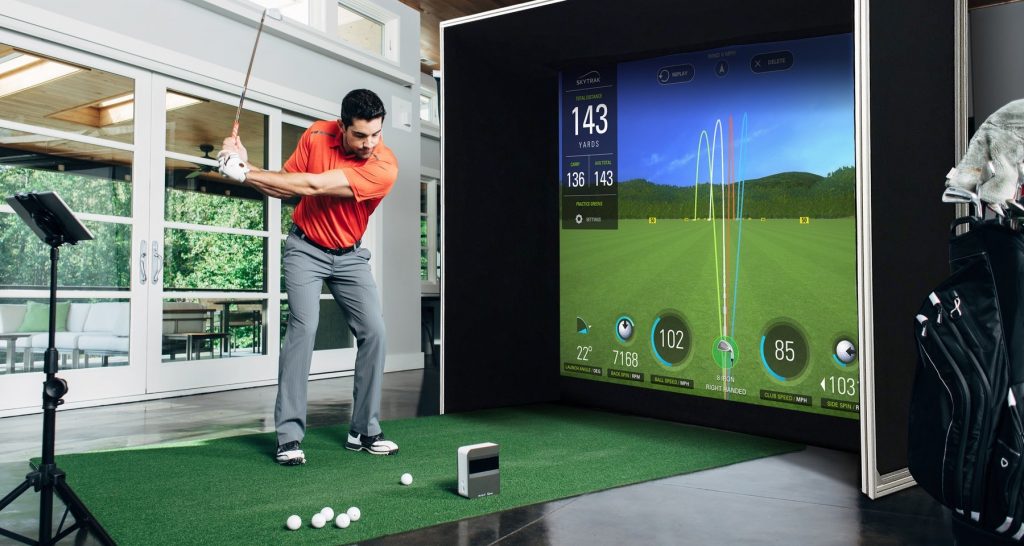Perhaps you have heard about the benefits of golf simulators. Possibly you are looking to improve your game. Maybe your wife made you move to Seattle where it rains 300 days a year, and you know a golf simulator is cheaper than a divorce. No matter the reason, before you pull out your wallet, you should know how golf simulators work.
There is a lot more to it than just turning on a computer and grabbing your 4-iron. Let’s break the process down so you get an understanding of how they work and why they can help you improve.
Table of Contents
The Game Within a Game
The first thing to realize is that while a golf simulator is a tool, it is also a game. In essence, a simulator is a giant virtual reality game, just without the weird goggles and fancy gloves. You are hitting a real golf ball with a real club.
Once the system is set up, you will tee off, use irons and putt while playing on a virtual course. Many systems use real courses from around the world. So, if you have ever wanted to play TCP Sawgrass, now is your chance.
Using the simulator as a tool, there are several factors you need to consider. Mainly, the weather conditions. When you go out and play a round in real life, you are subject to wind, humidity, rain, and sunshine. Because the simulator is set up in your home, these conditions won’t affect your swing.
Ironically, human nature also prevents us from taking a real, full swing. At least for a little while. You may be thinking about breaking grandma’s vase or putting a hole in the drywall. Whatever the cause, there will be a slight hesitation and hold-back in your swing compared to being on the driving range.
Once you get past this stage, though, the simulator can use its programming and sensors to give you an accurate portrayal of your golf game.
Sensors Galore
There are many types of golf simulators to purchase — everything from small, portable kits to elaborate setups that cost thousands. In a world where “you get what you pay for,” a golf simulator follows suit.
Every simulator will have at least one type of sensor. Generally, this will be the mat you stand on and hit from. The mats are designed with sensors to judge club speed, impact speed, and direction of ball travel. Using advanced algorithms, the computer will be able to decide how far the ball will travel and in what direction.
More expensive units like the SkyTrak will use high-speed cameras, infrared sensors, and even touch-based sensors on the screen. The more sensors you have, the more accurate your readings will be.
If you want a simulator as a giant video game, any option will suffice. However, if you are looking to analyze your swing, improve your game and ball control, you will need to pay for a higher-end system.
Infrared sensors will create a plane that your club and the ball pass through. This will accurately give you feedback on the actual angle, distance, and speed. High-speed cameras will capture your golf swing. You can review your shot to see where you went wrong (although, your front foot is probably too far forward).

The touch sensors in the screen will judge impact location, power, and height. When calculated, these will give you the direction and distance of the ball and the game will show your shot flying down the fairway just as it would in real life.
Settings and Controls
Once you have played a few rounds on a simulator, you will notice that the readings might not be what you expect. No system is perfect, and often you will find that after an initial round, your numbers are way off. Perhaps it shows you hitting your 9-iron further than your 5-wood. Or that you regularly hook the ball when in real life it is always a draw.
You will need to calibrate the machine, tweak settings, and ensure the system is mounted properly. Everything is dependent on dialing in the settings to your specific swing and play style. Of course, if you don’t install the camera high enough, for example, you will notice your shots displaying as way off the mark.
Have you had any experience with a golf simulator? Let us know what type you used and which sensors were involved. Use the comment section below to give us all the juicy details as well as your embarrassing moments!
